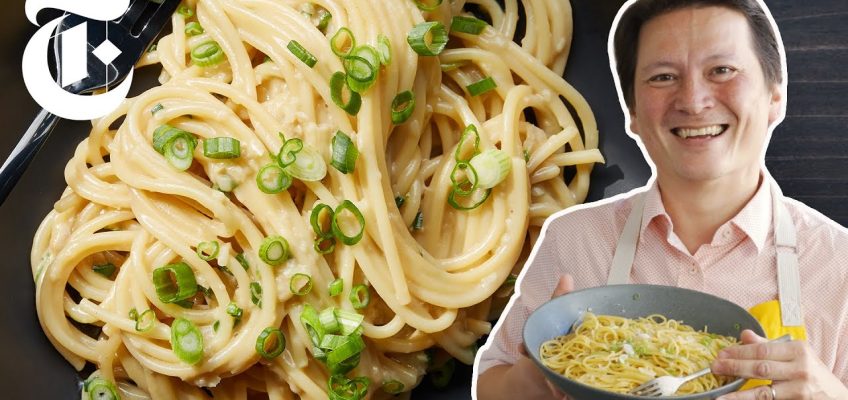It seems but it is definitely a dish for Garlic Lovers first thing I'm going to Do is start with some water and I'm Putting this in a skillet as opposed to A deep pot which I'll explain in a Little bit when we're actually cooking The pasta but first thing I'm going to Get this going to a boil at 10 long they Use fresh wheat noodles I like to make This dish at home with spaghetti because I find it to be well first of all I Always have dried spaghetti at home and I rarely have fresh wheat noodles uh and I also sort of like the nod to the more Sort of Italian and Italian American uh Traditions uh so using dried spaghetti Works really well for this dish all Right and while that comes to a boil I'm Going to start working with my garlic so 20 cloves of garlic there's a number of Ways you can prepare your garlic and Sort of depending on how you prepare it You get different flavors out of it you So garlic the flavor that we strongly Associate with garlic sort of the Pungent spicy Stuff those flavors don't exist in raw Garlic um they only exist once you cut Open garlic cells um these pre precursor Chemicals come out and combine and form Those flavor compounds that give garlic It sort of heat and so depending on how You cut the garlic you're going to form More or less of those compounds also the
More cells you rupture when you're uh Preparing your garlic the stronger that Flavor is going to be and so in order to Sort of get the maximum amount of garlic Flavor I like to use a mortar and pestle Because a mortar and P Crushes as opposed to Simply sort of Shears apart cells you know it's like When Godzilla comes and steps on the on The shipping yard and crushes all those Containers and really releases Everything so you get much more flavor Using a mort mortar and puzzle than uh Just chopping it with a knife so I'm Going to roughly chop those garlic Cloves just to get them started add a Little pinch of salt the salt does a Couple things early on in the in the Process it acts as an abrasive uh so it Really helps the the garlic kind of Grind Down and eventually as that salt you Know it pretty quickly is going to Dissolve into the juices of the garlic That you're pulling out so I'm not going For a total paste here doesn't have to Be super Fine I think that looks about right so There's still some kind of chunks in There so now butter we don't want the Butter to Brown though we just want to Kind of melt it you know we're going for Sort of that milder cooked garlic flavor That is not yet um to the point where
It's sort of Browning or really Developing any of those darker flavors Oh man that's pungent yeah we're going To let it soften and cook oh and by the Way once you get it pounded in the Mortar and pestel those really stronger You know the the the kind what I called The lacrimator the things that get your That get into your eyes and get into the Back of your nose those flavor compounds Will start to develop um relatively Rapidly so you do want to make sure that You pound the garlic just before you Start using it otherwise it'll start to Get a little bit too strong this is also One of those situations where if you Know you go to the farmers market and You find that really nice garlic the Really nice fresh garlic or some kind of Special variety of garlic that you want To try out this is a great dish to do do That with all right so our water's Coming up to a boil I'm not going to Season it as heavily with salt as I Would if I had like a big pot because What's going to happen is this pasta Water is going to get sort of very Concentrated uh and we're going to add It to our sauce later on there's already A bunch of other salty ingredients going Into the sauce so we don't want to put Too much salt in that water all right so I think at this point our garlic is like On the verge of starting to Brown which
I don't want to happen so I'm going to Lower the heat and I'm going to start Adding my sauces so soy sauce fish Sauce and Oyster sauce so these three sauces all Of them are sort of you know what I what I refer to as Umami bombs um so it's a Big Umami party in here so the reason I'm cooking this spaghetti in a uh Smaller Skillet as opposed to a big pot You can see it already the water is Starting to get kind of Cloudy and Starchy and that's all stars that starch That's being boiled off from the pasta Itself that starchy pasta water Obviously is going to help our sauce Emulsify later on and make it really Nice and creamy um so that all the all The spaghetti gets coated really well in That sauce if you were to boil this in a Very big pot you end up diluting that Starch so it doesn't work as effectively I used to work in an Italian restaurant You know at the beginning of service When the water was completely fresh it Was really hard to get pasta sauces to Emulsify properly and then over the Course of the evening as you were Cooking you know use the same water to Cook pasta so it would get starchier and Starchier and starchier um and so the Pasta dishes would actually get better As the night went on so if you got a Late reservation at an Italian
Restaurant you're probably getting Better pasta than if you got that first Reservation you know the one thing when You when you cook in a skillet like this As opposed to a big pot you do have to Stir it a little bit more cuz at the Very start especially there's a chance That you know the surface starch on the Pasta is going to get it all to stick Together so you want to make sure that Those strands of spaghetti are separated From each other so we're going for shy Dente which means we want the pasta to Be tender but still have more than a Little bite in the center so the the Very center of it should actually taste A little bit undercooked I'm not going To drain the pasta I'm just going to Lift it with tongs and whatever water Sort of comes with it stays with it I'm Going to keep the skillet of pasta water On the side uh just to adjust things as I Go it's always a good idea to keep to Reserve that pasta water because there's Nothing better for sort of adjusting the Consistency of your of your sauce at the End once you get the pasta in your Skillet like this it kind of enters what My friend and colleague Daniel gritzer Over at serious seats he calls it pasta Bullet time where essentially once you Get it into the sauce it Cooks slower Than it would in just the plain water
Mainly because there you know there's Acid in the sauce and so the way the Pasta absorbs water the way the starch Cooks is a little bit slower and a Little bit different so even though in Here it probably would have been done in About a minute we now probably have like 2 or 3 minutes to get it done in here so It buys you a little bit of time all Right so I can hear it's kind of Sizzling which which tells me that There's not enough water in there that Sizzling is a sound of frying which Indicates that the water has boiled off A little too much so you want to hear More of like a you know like a Sputtering as opposed to a a Sizzle we Don't want to fry the spaghetti we want To get it nice and Creamy I'm doing this at at the highest Heat by the way cuz we want to sort of Encourage real rapid boiling because That also is going to help with the uh Emulsification M all right so we are now basically at Al Dente which means this is Done I want it to be actually slightly Looser in the pan than I want to serve It because as it cools it's going to Thicken up a bit and of course in the Time that it takes to get that pasta to The table it's also going to absorb some Of that liquid but you can see here how Nice and sort of creamy this sauce has
Become and that's just from all the all The starch in the pasta all right so at The very end we're going to shut off the Heat we'll add our cheese I'm going to Reserve a tiny bit to sprinkle on at the End add some scallions scallions are Totally optional I think typically not Even in the the dish at the restaurant But I like them another thing I like to Add here is any kind of sort of salted Preserved fish eggs you know I like to Do it with uh men Tao so Japanese salted POC row but you could also do it with Something like you know shaved batara You could do it with like flying fish Row I I think fish eggs go really nicely In this all right so we're just going to Give it a few turns until it's that Cheese is uh distributed and Everything's nice and creamy and so what You want to see is the uh is is this Sort of creamy texture of the sauce Clinging to the Spaghetti you don't want To see it watery you don't want to see Your spaghetti kind of just pull up Loose you want it to really cling to There and I think we're at that Point All right so this is it um you saw I I Added the cheese off heat by the way the Cheese and the scallions off heat uh the Cheese is really sort of the more Important part to do off heat if you add It while it's on the heat you sort of
Increase the chance that the cheese is Going to Clump up uh and turn into sort Of like a congealed ball of Parmesan Instead of staying creamy and emulsified You know the amount of pasta water we Had in here and the starchiness of that Pasta water really goes a long way in Making sure that doesn't happen but it's Still a risk and so to mitigate that Risk you always add the cheese off heat And toss it in I like to see the garlic Clinging to it like That super garlicky really Umami I mean Know ites it has like all the things That you want out of like garlic Spaghetti you know it has a little bit Of that sort of like kacho Pepe real Intense sort of cheesiness to it Umami [Music] Flavor that's a good bowl of [Music] Noodles

Have you ever wondered why most of the Vinaigrettes in the grocery store are made with 10, 20, sometimes even almost 30 ingredients? I remember growing up in Provence watching my mother whipping vinaigrettes before every single dinner. She would mix in a giant bowl, delicious extra virgin olive oil, a robust aged vinegar (the flavor would depend on the main dish), sea salt and pepper and voila! I decided to do the same thing for my family and friends more than 20 years ago here in this beautiful country. And Provence Kitchen® was born. Stay tune for more articles and wonderful family recipes..


Leave a Reply